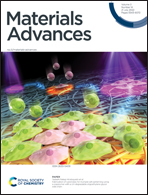Enhancing the third-order nonlinearity and crystallinity by selenium incorporation in tin sulfide films (SnS1−xSex) for optoelectronic applications
Abstract
Thin films of SnS1−xSex with varying Se (x = 0, 0.1, 0.15, 0.2, 0.25) contents were deposited by the thermal evaporation method on glass substrates at room temperature. The crystalline nature of the films is verified using structural characterization techniques such as X-ray diffraction and Raman analysis. The crystallinity increased with Se concentration. The nanoflake-like structure with an increase in size and density upon Se addition is observed from the morphology study through field emission scanning electron microscopy. The energy-dispersive X-ray analysis confirmed the elemental % in different films. The transmittance data were recorded in the range of 900–1100 nm by UV-Vis spectroscopy and used to evaluate the linear/nonlinear optical properties. The transmission percentage decreased with the doping of Se in the SnS binary compound. The absorption and extinction coefficients were enhanced with Se content. The bandgap value decreased with the doping concentration. The optical energy gap is used to evaluate the static refractive index using Dimitrov and Sakka's relation. The value of the static refractive index increased with Se content, which further helped to enhance the nonlinear optical parameters. The nonlinear parameters such as the nonlinear refractive index and third-order nonlinear susceptibility increased with the Se concentration. The theoretically calculated physical parameters like the average heat of atomization decreased with Se content. Tuning of nonlinear and linear properties by varying the selenium doping content in SnS1−xSex films will be useful in many photonic and optoelectronic devices.



 Please wait while we load your content...
Please wait while we load your content...